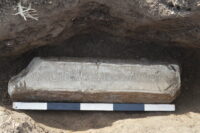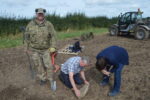 An inscribed Roman lead pig designated of national importance has been acquired by the Wrexham Museum. It was discovered last September by metal detectorist Rob Jones in a field near Rossett, northeastern Wales. He dug up a corner of the object, saw that it had an inscription on it and alerted the local finds liaison officer.
An inscribed Roman lead pig designated of national importance has been acquired by the Wrexham Museum. It was discovered last September by metal detectorist Rob Jones in a field near Rossett, northeastern Wales. He dug up a corner of the object, saw that it had an inscription on it and alerted the local finds liaison officer.
Archaeologists from the Wrexhamn Museum and Clwyd-Powys Archaeological Trust fully excavated the find and surrounding area. The  object turned out to be a large lead ingot or pig. It is a rectangle on the long sides with a trapezoid cross-section. At its maximum dimensions, it is 21 inches long, 6.3 inches wide and 4.3 inches high. Some of the lead is missing from one end of it and there are copious cut marks on the surfaces. It weighs 140 pounds.
object turned out to be a large lead ingot or pig. It is a rectangle on the long sides with a trapezoid cross-section. At its maximum dimensions, it is 21 inches long, 6.3 inches wide and 4.3 inches high. Some of the lead is missing from one end of it and there are copious cut marks on the surfaces. It weighs 140 pounds.
Lead was mined and processed in several areas of the new province including in north-east Wales where lead processing sites have been excavated near Flint, presumably smelting ores extracted from the nearby Halkyn Mountain. A number of lead ingots of slightly later date are known from these works, often marked with the name of the local pre-Roman tribe called the Deceangli.
Susie White, the local Finds Officer (NE Wales) commented “It has been suggested in the past that similar exploitation took place in the Wrexham area around Minera and particularly Ffrith, where there is a known Roman site, although clear evidence is absent, probably as the result of more recent mining activity.
“We don’t yet know where this ingot has come from and we will probably never know where it was going to. However given the find spots of other ingots from Britain of similar date, it may have been destined for continental Europe, perhaps even Rome itself. The object could tell us a great deal about this important period of our past, a period which is still poorly understood in this area of the country.”
Fewer than a hundred such lead ingots from Roman Britain are known today, and the inscription on this one makes it undisputably one of a kind. It is almost intact, missing only the very beginning which we can interpolate easily from the information in the rest of the inscription. It reads: CAES ^ AVG ^ BR͡IT ^ X ṂAGVL ^ F̣VSVM ^ OP I͡N ^ P͡ROV ^ T͡R͡EB͡E͡L ^ MAXIMO ^ LEG ^ AVG. In full words: [Neronis] Caes(aris) Aug(usti) (plumbum) Brit(annicum) (e)x Magul(…) fusum op(eribus) in prov(incia) Trebel(lio) Maximo leg(ato) Aug(usti). Translation: (Property) of Nero Caesar Augustus, British (lead) from Magul(…), smelted at the works in the province when Trebellius Maximus was imperial legate.
Marcus Trebellius Maximus served as governor of Britannia under Nero from 63-69 A.D. In the wake of the Boudiccan revolt of 60/1, Trebellius’ aim was to pacify and stabilize Britain and get to the business of exploiting the province’s rich mineral resources, one of the main motivations for Claudius’ conquest of the island.
He is known from ancient literary sources, primarily Tacitus who mentions him in the Annals, Agricola and the Histories, but very few inscriptions from the empire record his name. This is the only archaeological reference to Marcus Trebellius Maximus ever discovered in Britain.
It is among the earliest dated inscriptions recording Roman seizure of Britain’s mineral wealth and testifies to its rapid exploitation following the spread of Roman power across the island. The production of the ingot presupposes prospection for metals, expropriation of mining sites and the mobilisation of labour, forced or voluntary, to mine and process metal-rich ores. The inscription also illustrates the bureaucratic control exercised over the production of valuable metals.

